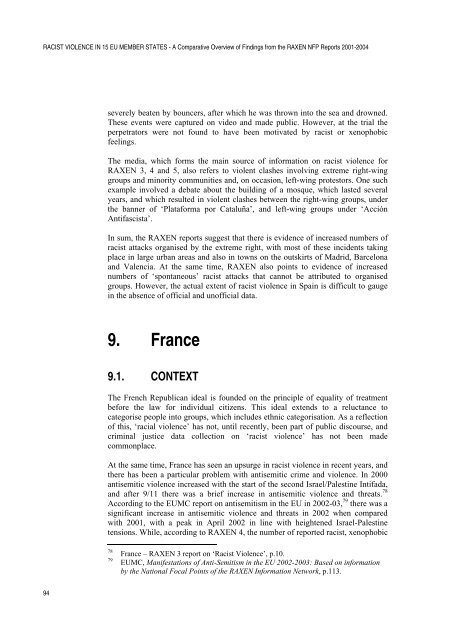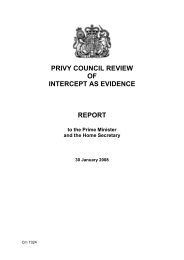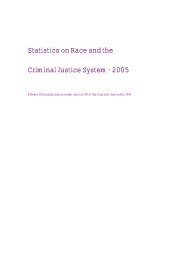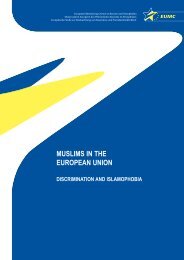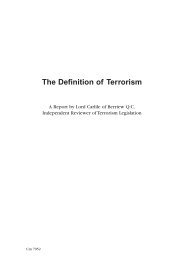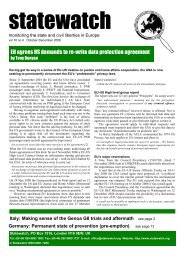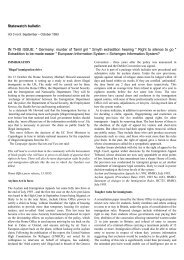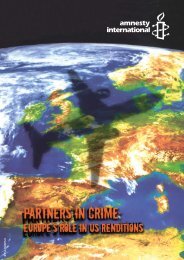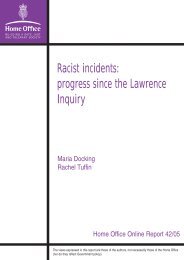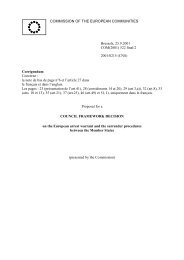RACIST VIOLENCE IN 15 EU MEMBER STATES - Cospe
RACIST VIOLENCE IN 15 EU MEMBER STATES - Cospe
RACIST VIOLENCE IN 15 EU MEMBER STATES - Cospe
Create successful ePaper yourself
Turn your PDF publications into a flip-book with our unique Google optimized e-Paper software.
<strong>RACIST</strong> <strong>VIOLENCE</strong> <strong>IN</strong> <strong>15</strong> <strong>EU</strong> <strong>MEMBER</strong> <strong>STATES</strong> - A Comparative Overview of Findings from the RAXEN NFP Reports 2001-2004<br />
severely beaten by bouncers, after which he was thrown into the sea and drowned.<br />
These events were captured on video and made public. However, at the trial the<br />
perpetrators were not found to have been motivated by racist or xenophobic<br />
feelings.<br />
The media, which forms the main source of information on racist violence for<br />
RAXEN 3, 4 and 5, also refers to violent clashes involving extreme right-wing<br />
groups and minority communities and, on occasion, left-wing protestors. One such<br />
example involved a debate about the building of a mosque, which lasted several<br />
years, and which resulted in violent clashes between the right-wing groups, under<br />
the banner of ‘Plataforma por Cataluña’, and left-wing groups under ‘Acción<br />
Antifascista’.<br />
In sum, the RAXEN reports suggest that there is evidence of increased numbers of<br />
racist attacks organised by the extreme right, with most of these incidents taking<br />
place in large urban areas and also in towns on the outskirts of Madrid, Barcelona<br />
and Valencia. At the same time, RAXEN also points to evidence of increased<br />
numbers of ‘spontaneous’ racist attacks that cannot be attributed to organised<br />
groups. However, the actual extent of racist violence in Spain is difficult to gauge<br />
in the absence of official and unofficial data.<br />
9. France<br />
9.1. CONTEXT<br />
The French Republican ideal is founded on the principle of equality of treatment<br />
before the law for individual citizens. This ideal extends to a reluctance to<br />
categorise people into groups, which includes ethnic categorisation. As a reflection<br />
of this, ‘racial violence’ has not, until recently, been part of public discourse, and<br />
criminal justice data collection on ‘racist violence’ has not been made<br />
commonplace.<br />
At the same time, France has seen an upsurge in racist violence in recent years, and<br />
there has been a particular problem with antisemitic crime and violence. In 2000<br />
antisemitic violence increased with the start of the second Israel/Palestine Intifada,<br />
and after 9/11 there was a brief increase in antisemitic violence and threats. 78<br />
According to the <strong>EU</strong>MC report on antisemitism in the <strong>EU</strong> in 2002-03, 79 there was a<br />
significant increase in antisemitic violence and threats in 2002 when compared<br />
with 2001, with a peak in April 2002 in line with heightened Israel-Palestine<br />
tensions. While, according to RAXEN 4, the number of reported racist, xenophobic<br />
78<br />
79<br />
France – RAXEN 3 report on ‘Racist Violence’, p.10.<br />
<strong>EU</strong>MC, Manifestations of Anti-Semitism in the <strong>EU</strong> 2002-2003: Based on information<br />
by the National Focal Points of the RAXEN Information Network, p.113.<br />
94


